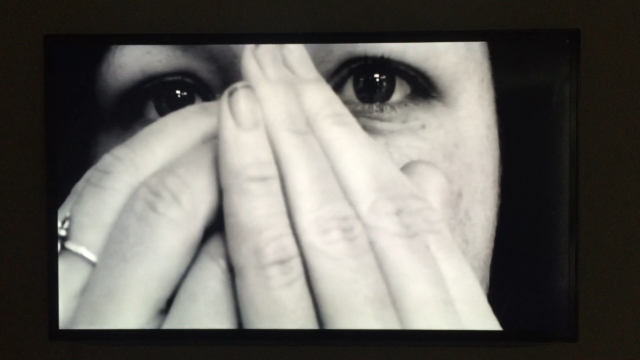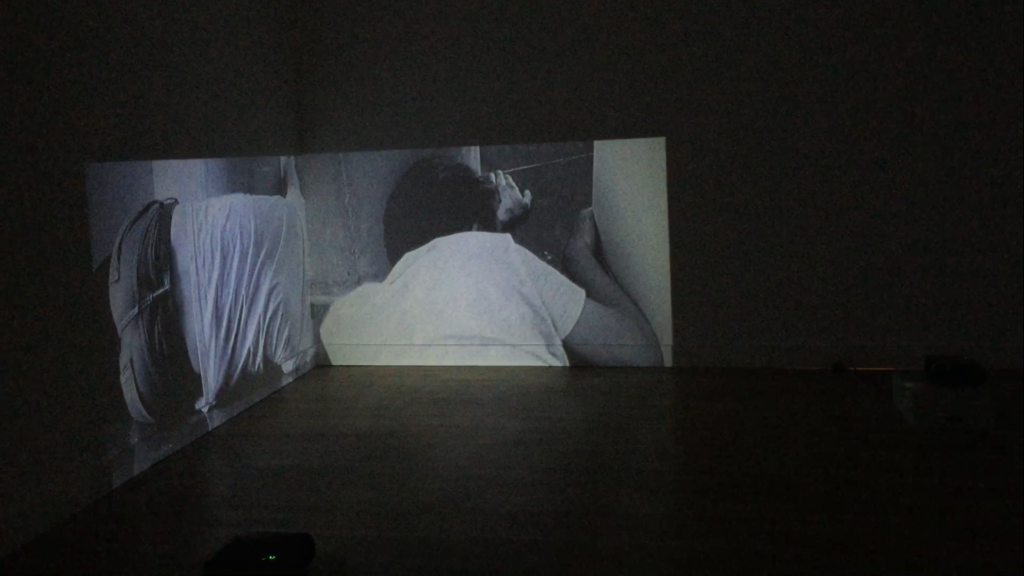
Walk into the main gallery of the Boulder Museum of Contemporary Art (BMoCA) and you will be blinded by industrial spotlights mounted on large white boxes, shining with blaring aggression. Upon seeing the light, you will instinctively squint, raise your hands to your face to shield your eyes and shift your body to ward against the glare, as you try to find your bearings.
Shining light into someone’s eyes is a basic military tactic used both to identify and disorient a potential threat, creating a power imbalance as one is seen without themselves being able to see.
“We want you to not be able to look at [the boxes] so as to introduce a way of hiding by becoming something that you can’t look at. The boxes become invisible in plain sight,” says Matt Fischer of Finishing School, the Los Angeles-based artist collective behind BLISS, on exhibition at BMOCA through September 11.
The lights are mounted at eye level on three large, white cubes that mimic the classic white and square gallery room. The boxes are shelters designed to be like bunkers that offer protection and isolation in times of war. Constructed of thick kevlar and other ballistic materials they are completely impenetrable — bulletproof, soundproof, impermeable to radio waves, Wi-Fi and heat sensors.
 The piece isn’t finished until someone shuts themselves inside a bunker, entering a completely private space where there is no way for outsiders to know what is done inside. Once the door on the shelter is closed, a strict barrier is formed between the inside and the outside world and the participants find themselves uniquely and totally alone.
The piece isn’t finished until someone shuts themselves inside a bunker, entering a completely private space where there is no way for outsiders to know what is done inside. Once the door on the shelter is closed, a strict barrier is formed between the inside and the outside world and the participants find themselves uniquely and totally alone.
Stepping into such true privacy draws a strict contrast to the mass surveillance at work in the world today. It is as if there has been a subtle takeover in which what was once considered a right is now only an afterthought. Fischer says the goal of the exhibition is not only to question what it means to lose privacy, but for the viewer to consider their participation in that process.
In seeking both physical and psychological participation there is a transactional aspect to BLISS — an intentional acknowledgement that the era of surveillance isn’t just happening to us but comes with our consent. The justifications come in many forms — from national security to corporate interest to personal comfort and social connectivity — all of which work to create a network of surveillance with profound effects on our understanding of humanity.
“We are all going through this social experiment for the first time, together,” Fischer says. “It’s not like we know more about this than anyone else. With the rapid way that culture has changed in the last ten years, there is no one on the planet that has the perspective to be able to speak on it rationally because we are all doing it simultaneously. There is no way to really gain a firm point of view on what is actually happening.”
The title of the show, BLISS, is a subtle callback to such repercussions of lost privacy. Finishing School offers three definitions of the word, the first two reference a sort of salvation: complete happiness or, in the philosophical sense, a perfect place of peace.
 The third definition, however, is a military acronym used to instruct soldiers to find and construct shelter in a survival situation — Blend in, keep a Low profile, build an Irregular shape, stay Small, find a Secluded location.
The third definition, however, is a military acronym used to instruct soldiers to find and construct shelter in a survival situation — Blend in, keep a Low profile, build an Irregular shape, stay Small, find a Secluded location.
“It’s interesting when you read the survival manuals for when you’ve been shot down behind enemy lines. The first steps that they take you through are really psychological,” Fischer says. “It is not things to do physically, rather it is ways to set up your mind. It was this weird mix of psychology and movement that really seemed like it was hitting the nail on the head. To complement the psychological experience of the front room, in the back room we incorporated movement related to the sense of military authoritarianism. They are really opposite in an important way.”
The back half of the exhibition, done in collaboration with artists from the University of Colorado Boulder, shows videos of people moving slowly through militarized evasion tactics and performing everyday acts of privacy. A woman blinks, a man crawls into a corner, a woman covers her mouth to hide her breathing and another woman crouches low and shuffles side to side, her back pressed firmly against a wall.
Compared to the blank architecture of the front gallery, the movement portrayed in the back room is starkly corporeal and gestural. The embodiment of evasion and the performance of blending-in exposes the vulnerability in being seen. There is an implicit sadness in having to hide oneself as if, without privacy, we are all somehow living behind enemy lines.
“I think we have a right to be able to erase parts about ourselves, or at least let them drift off organically the way that they have in the past, as they have for hundreds of thousands of years,” Fischer says. “I think there is something really wonderful about moments passing and being forgotten.”
On the bill: Finishing School: BLISS. Boulder Museum of Contemporary Art, 1750 13th St., 303-443-2122. Through September 11.














